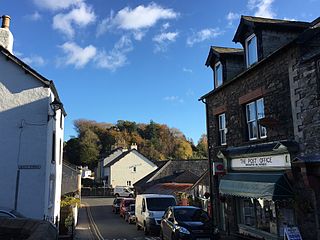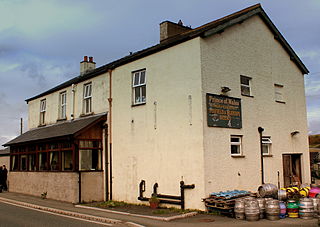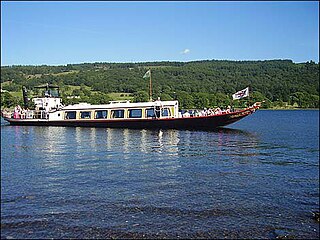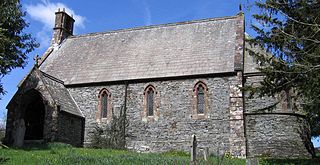
The Furness Railway (Furness) was a railway company operating in the Furness area of Lancashire in North West England.

Furness is a peninsula and region of Cumbria, England. Together with the Cartmel Peninsula it forms North Lonsdale, historically an exclave of Lancashire. On 1 April 2023 it became part of the new unitary authority of Westmorland and Furness.

The Old Man of Coniston is a fell in the Furness Fells of the Lake District in Cumbria, England, and is the highest point of the historic county of Lancashire. It is at least 2,632.62 feet (802.42 m) high, and lies to the west of the village of Coniston and the lake, Coniston Water. The fell is sometimes known by the alternative name of Coniston Old Man, or simply The Old Man. The mountain is popular with tourists and fell-walkers with a number of well-marked paths to the summit. The mountain has also seen extensive copper and slate mining activity for eight hundred years, and the remains of abandoned mines and spoil tips are a significant feature of the north-east slopes.

The Cumbrian Coast line is a rail route in North West England, running from Carlisle to Barrow-in-Furness via Workington and Whitehaven. The line forms part of Network Rail route NW 4033, which continues via Ulverston and Grange-over-Sands to Carnforth, where it connects with the West Coast Main Line.

The Furness line is a British railway between Barrow-in-Furness and Lancaster, joining the West Coast Main Line at Carnforth. A predominantly passenger line, it serves various towns along the Furness coast, including Barrow-in-Furness, Ulverston and Grange-over-Sands. It runs through Cumbria and Lancashire.

Under the Whyte notation for the classification of steam locomotives, 0-4-2 represents the wheel arrangement with no leading wheels, four powered and coupled driving wheels on two axles and two trailing wheels on one axle. While the first locomotives of this wheel arrangement were tender engines, the configuration was later often used for tank engines, which is noted by adding letter suffixes to the configuration, such as 0-4-2T for a conventional side-tank locomotive, 0-4-2ST for a saddle-tank locomotive, 0-4-2WT for a well-tank locomotive and 0-4-2RT for a rack-equipped tank locomotive.

Foxfield is a railway station on the Cumbrian Coast Line, which runs between Carlisle and Barrow-in-Furness. The station, situated 11+1⁄2 miles (19 km) north of Barrow-in-Furness, serves the villages of Broughton-in-Furness and Foxfield in Cumbria. It is owned by Network Rail and managed by Northern Trains.

Broughton in Furness is a market town in the civil parish of Broughton West in the Westmorland and Furness district of Cumbria, England. It had a population of 529 at the 2011 Census. It is located on the south western boundary of England's Lake District National Park, and in the Furness region, which is within the historic boundaries of Lancashire.

Askam is a railway station on the Cumbrian Coast Line, which runs between Carlisle and Barrow-in-Furness. The station, situated 6 miles (10 km) north of Barrow-in-Furness, serves the villages of Askam-in-Furness and Ireleth in Cumbria. It is owned by Network Rail and managed by Northern Trains.

Foxfield is a village on the west coast of Cumbria, England, in the Furness district that was part of Lancashire from 1182 to 1974. It lies on the Duddon Estuary, just outside the Lake District National Park, around ten miles to the north-east of Barrow-in-Furness and one mile out of Broughton-in-Furness. It is part of the parish of Broughton West.

Coniston railway station was the northern terminus of the Coniston branch line in the village of Coniston, Lancashire, England.
The Otavi Mining and Railway Company was a railway and mining company in German South West Africa. It was founded on 6 April 1900 in Berlin with the Disconto-Gesellschaft and the South West Africa Company as major shareholders.

The steam yacht Gondola is a rebuilt Victorian, screw-propelled, steam-powered passenger vessel on Coniston Water, England. Originally launched in 1859, she was built for the steamer service carrying passengers from the Furness Railway and from the Coniston Railway. She was in commercial service until 1936 when she was retired, being converted to a houseboat in 1946. In 1979, by now derelict, she was given a new hull, engine, boiler and most of the superstructure. She is back in service as a passenger boat, still powered by steam and now operated by the National Trust.

Torver railway station served the village of Torver, in Lancashire, England. It was on the branch line to Coniston.

Broughton-in-Furness railway station served the market town of Broughton-in-Furness, in Lancashire, England. It was on the branch line to Coniston.

Woodland railway station served the hamlet of Woodland, in Lancashire, England. It was on the branch line to Coniston.
Lindal railway station served Lindal-in-Furness in the Furness area of Lancashire, England .

Woodland is a dispersed hamlet within the civil parish of Kirkby Ireleth in the Furness region of Cumbria, England, and is located in the southern part of the Lake District National Park, west of Coniston Water, between Torver and Broughton-in-Furness.

Island Road railway station was a railway station at the centre of Barrow Island, Barrow-in-Furness, England which operated between 1899 and 1967. It was built by the Furness Railway near the junction of the Ramsden Branch Line and a line which ran through the industrial areas of the town.


















